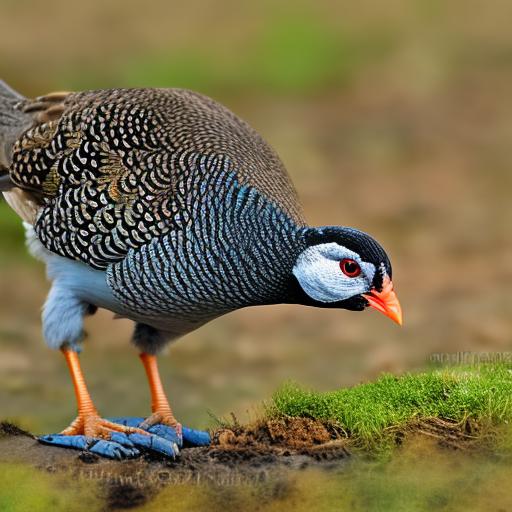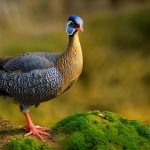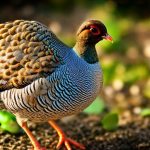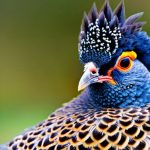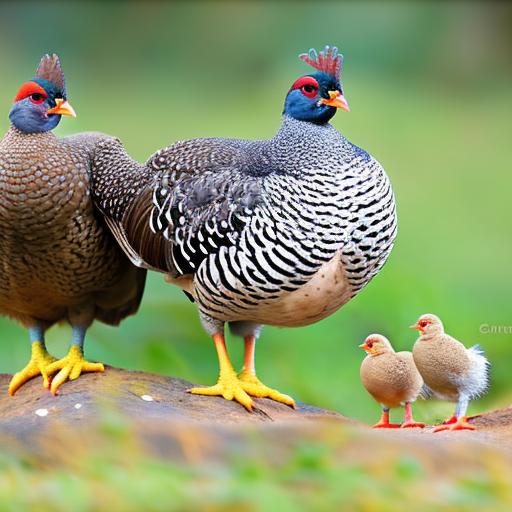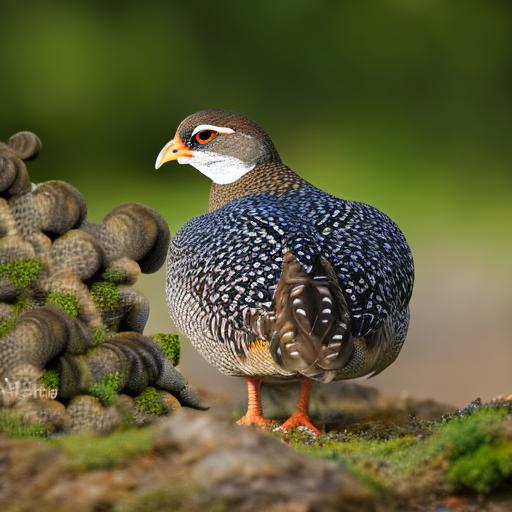Guinea fowl are known for their curious and active nature. They are social birds that prefer to live in flocks, and they are highly alert and vigilant, making them excellent watch birds. Guinea fowl are also known for their strong flight capabilities, which can make them prone to escaping from their enclosures if not properly managed. Understanding the behavior of guinea fowl is crucial in order to provide them with a suitable environment and prevent them from flying away.
Guinea fowl are ground-dwelling birds that prefer to roost in trees at night. They are highly adaptable and can thrive in a variety of environments, from open grasslands to wooded areas. They are also known for their foraging behavior, as they spend much of their time searching for insects, seeds, and other small creatures on the ground. Additionally, guinea fowl are known for their strong flocking instinct, and they prefer to stay close to their companions at all times. Understanding these natural behaviors can help in creating an environment that meets their needs and reduces the likelihood of escape.
Key Takeaways
- Guinea fowl are social birds that exhibit flocking behavior and prefer to roost in trees at night.
- A suitable enclosure for guinea fowl should be spacious, predator-proof, and include roosting areas and shelter.
- Clipping the wings of guinea fowl can prevent them from flying long distances and escaping from the enclosure.
- Behavioral training techniques such as positive reinforcement can be used to train guinea fowl to stay within the designated area.
- Visual deterrents such as scarecrows or reflective tape can help prevent guinea fowl from attempting to fly out of the enclosure.
- Providing adequate food and water within the enclosure can help keep guinea fowl grounded and less likely to seek out escape routes.
- Regular monitoring of the enclosure and addressing any potential escape routes can help prevent guinea fowl from escaping.
Providing a Suitable Enclosure for Guinea Fowl
Creating a suitable enclosure for guinea fowl is essential in preventing them from flying away. The enclosure should be spacious enough to allow the birds to move around freely and engage in their natural behaviors, such as foraging and socializing. It should also be secure enough to prevent them from escaping, with high walls or fences that are difficult for them to fly over. Additionally, the enclosure should provide shelter from the elements and predators, as well as roosting areas for the birds to rest at night.
The flooring of the enclosure should be covered with grass or other vegetation to mimic their natural habitat and provide a comfortable surface for foraging. Providing perches and branches within the enclosure can also give the guinea fowl opportunities to roost and feel secure. It’s important to regularly inspect the enclosure for any potential escape routes, such as gaps in the fencing or low-hanging branches that could provide a means of escape. By providing a suitable enclosure that meets the needs of guinea fowl and prevents them from flying away, you can ensure their safety and well-being.
Clipping the Wings of Guinea Fowl
Clipping the wings of guinea fowl is a common practice used to prevent them from flying away. This involves trimming the primary feathers on one wing to reduce their ability to achieve lift and fly long distances. Wing clipping should be done carefully and with proper guidance to ensure that it is done safely and effectively. It’s important to note that wing clipping is a temporary solution and will need to be repeated as the feathers grow back.
When clipping the wings of guinea fowl, it’s crucial to avoid cutting into the blood feathers, as this can cause pain and bleeding. The primary feathers should be trimmed just enough to prevent flight while still allowing the bird to glide safely to the ground. It’s also important to monitor the regrowth of the feathers and re-clip them as needed to maintain the desired level of flight restriction. While wing clipping can be an effective method for preventing escape, it’s important to consider other factors such as providing a suitable enclosure and implementing behavioral training techniques to ensure the well-being of the birds.
Implementing Behavioral Training Techniques
Implementing behavioral training techniques can help in managing the flight behavior of guinea fowl and reducing the likelihood of escape. Positive reinforcement training methods can be used to teach guinea fowl to respond to cues and commands, making it easier to manage their behavior and keep them grounded. Training can also help in building trust between the birds and their caretakers, making it easier to handle them and address any potential escape attempts.
Training can involve using treats or rewards to encourage desired behaviors, such as returning to the enclosure or staying within a certain area. Consistency and patience are key when implementing training techniques, as it may take time for the birds to learn and respond to commands. It’s important to start training at a young age when the birds are more receptive to learning new behaviors. By implementing behavioral training techniques, you can establish a positive relationship with your guinea fowl and reduce the risk of escape.
Using Visual Deterrents to Prevent Flight
Using visual deterrents can help in preventing guinea fowl from flying away by creating a visual barrier that discourages flight. Visual deterrents can include objects such as scarecrows, reflective tape, or shiny objects that create movement and noise in the wind. These visual deterrents can create a sense of unease for the birds, making them less likely to attempt flight.
Placing visual deterrents around the perimeter of the enclosure or in areas where the birds are prone to escape can help in deterring flight behavior. It’s important to regularly move and change the position of visual deterrents to prevent the birds from becoming accustomed to them. Additionally, combining visual deterrents with other methods such as wing clipping and behavioral training can provide a comprehensive approach to preventing flight and keeping guinea fowl grounded.
Providing Adequate Food and Water to Keep Guinea Fowl Grounded

Providing adequate food and water is essential in keeping guinea fowl grounded and content within their enclosure. Guinea fowl are active foragers that spend much of their time searching for food on the ground, so it’s important to provide a balanced diet that meets their nutritional needs. This can include a combination of commercial poultry feed, grains, seeds, fruits, and vegetables.
Ensuring access to fresh water at all times is also crucial for keeping guinea fowl healthy and grounded. Water should be provided in clean containers that are easily accessible within the enclosure. By meeting their dietary and hydration needs, you can help in keeping guinea fowl content within their environment and less likely to seek out food sources beyond their enclosure.
Monitoring and Addressing Potential Escape Routes
Regularly monitoring the enclosure for potential escape routes is essential in preventing guinea fowl from flying away. This can include inspecting fences for any gaps or weaknesses that could allow the birds to escape, as well as removing any low-hanging branches or structures that could provide a means of flight. It’s important to address any potential escape routes promptly to prevent the birds from attempting flight.
In addition to physical barriers, it’s important to consider environmental factors that could encourage flight behavior, such as nearby predators or disturbances that could startle the birds. By monitoring potential escape routes and addressing any vulnerabilities, you can create a secure environment that reduces the risk of escape for guinea fowl.
In conclusion, understanding the behavior of guinea fowl is crucial in providing them with a suitable environment and preventing them from flying away. By creating a secure enclosure, implementing behavioral training techniques, using visual deterrents, providing adequate food and water, and monitoring potential escape routes, you can help in keeping guinea fowl grounded and safe within their environment. With proper care and management, guinea fowl can thrive in captivity while minimizing the risk of escape.
If you’re looking for ways to keep your guinea fowl from flying away, you may also be interested in learning about the benefits of using a reliable chicken coop. Check out this informative article on the Producers Pride Sentinel Chicken Coop from Poultry Wizard. This coop is designed to provide a safe and secure environment for your poultry, helping to prevent them from wandering off or getting lost. Learn more about the Producers Pride Sentinel Chicken Coop here.
FAQs
What are guinea fowl?
Guinea fowl are a type of bird native to Africa. They are known for their distinctive spotted feathers and loud, chattering calls.
Why do guinea fowl fly away?
Guinea fowl are strong fliers and may fly away if they feel threatened, are startled, or are seeking better foraging opportunities.
How can I keep guinea fowl from flying away?
To keep guinea fowl from flying away, you can clip their flight feathers, provide a secure and spacious enclosure, and ensure they have access to plenty of food and water.
Is it safe to clip guinea fowl’s flight feathers?
Clipping a guinea fowl’s flight feathers is a safe and common practice that can help prevent them from flying away while still allowing them to move around freely on the ground.
What should I consider when building an enclosure for guinea fowl?
When building an enclosure for guinea fowl, it’s important to make sure it is secure, spacious, and provides protection from predators. Additionally, the enclosure should have areas for foraging and dust bathing.
What are some other ways to keep guinea fowl from flying away?
In addition to clipping their flight feathers and providing a secure enclosure, you can also train guinea fowl to recognize their home and return to it at night, and provide them with companionship to reduce their desire to fly away.
Meet Walter, the feathered-friend fanatic of Florida! Nestled in the sunshine state, Walter struts through life with his feathered companions, clucking his way to happiness. With a coop that’s fancier than a five-star hotel, he’s the Don Juan of the chicken world. When he’s not teaching his hens to do the cha-cha, you’ll find him in a heated debate with his prized rooster, Sir Clucks-a-Lot. Walter’s poultry passion is no yolk; he’s the sunny-side-up guy you never knew you needed in your flock of friends!

